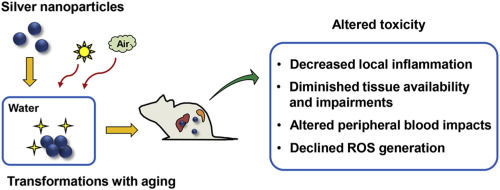Ecotoxicology and Environmental Safety ( IF 6.8 ) Pub Date : 2020-03-28 , DOI: 10.1016/j.ecoenv.2020.110487 Zhe Wang 1 , Qingqing Li 1 , Lining Xu 2 , Juan Ma 2 , Yan Wang 1 , Bing Wei 1 , Weidong Wu 1 , Sijin Liu 2

|
Despite numerous investigations into AgNP-induced toxicity, little has been taken into consideration the potential health impacts of aged AgNPs in comparison to fresh AgNPs. In the current study, we scrutinized the potential effects of aged AgNPs in animals. We first found that AgNPs underwent morphological transformations after natural ageing in aqueous solution upon exposure to air and sunlight for 9 days, as characterized by significant aggregation with increase of particle size approximately by 2 fold. Meanwhile, dissolved Ag ions from aged AgNPs increased by 33% compared to fresh AgNPs. Strikingly, the acute exposure results showed that aged AgNPs induced lower toxicity in mice relative to fresh AgNPs. Aged AgNPs caused milder local inflammation in the peritoneal cavity of mice, as evidenced by 63% reduction of tumor necrosis factor α (TNF-α) than that induced by fresh AgNPs. The deposition mass of aged AgNPs in the liver, spleen, lung and kidney was diminished by 69%, 39%, 83% and 40%, respectively, compared to the distribution profiles in response to fresh AgNPs. Whereby, milder splenic hyperemia was observed, and no significant hepatoxicity was found. Additionally, aged AgNPs provoked milder increase of periphery leukocytes and malondialdehyde (MDA) in mice in comparison to fresh AgNPs. Taken together, this study unraveled that the ageing process elicited remarkable alterations to physicochemical properties and toxic effects as well. This study would provide new insights into the potential health impacts of AgNPs under transformation-determined exposure scenarios.
中文翻译:

老化改变了银纳米颗粒的物理化学性质,因此损害了它们在哺乳动物中的急性毒性。
尽管对AgNP引起的毒性进行了大量研究,但与新鲜的AgNP相比,几乎没有考虑到老化的AgNP对健康的潜在影响。在当前的研究中,我们仔细研究了老年AgNPs对动物的潜在影响。我们首先发现,在暴露于空气和阳光下9天后,AgNPs在水溶液中自然老化后会发生形态转变,其特征是明显聚集,粒径增加约2倍。同时,与新鲜的AgNPs相比,老化的AgNPs中溶解的Ag离子增加了33%。令人惊讶的是,急性暴露结果表明,与新鲜的AgNPs相比,衰老的AgNPs对小鼠的毒性更低。老化的AgNP在小鼠腹膜腔内引起较轻的局部炎症,肿瘤坏死因子α(TNF-α)比新鲜AgNP诱导的减少63%证明了这一点。与响应于新鲜AgNPs的分布曲线相比,衰老的AgNPs在肝脏,脾脏,肺和肾脏中的沉积质量分别减少了69%,39%,83%和40%。因此,观察到较轻度的脾脏充血,未发现明显的肝毒性。此外,与新鲜的AgNPs相比,衰老的AgNPs引起小鼠外周血白细胞和丙二醛(MDA)的温和增加。两者合计,这项研究揭示了衰老过程引起了理化性质和毒性作用的显着改变。这项研究将提供有关转化确定的暴露情景下AgNPs潜在健康影响的新见解。与响应于新鲜AgNPs的分布曲线相比,衰老的AgNPs在肝脏,脾脏,肺和肾脏中的沉积质量分别减少了69%,39%,83%和40%。因此,观察到较轻度的脾脏充血,未发现明显的肝毒性。此外,与新鲜的AgNPs相比,衰老的AgNPs引起小鼠外周血白细胞和丙二醛(MDA)的温和增加。两者合计,这项研究揭示了衰老过程引起了理化性质和毒性作用的显着改变。这项研究将提供有关转化确定的暴露情景下AgNPs潜在健康影响的新见解。与响应于新鲜AgNPs的分布曲线相比,衰老的AgNPs在肝脏,脾脏,肺和肾脏中的沉积质量分别减少了69%,39%,83%和40%。因此,观察到较轻度的脾脏充血,未发现明显的肝毒性。此外,与新鲜的AgNPs相比,衰老的AgNPs引起小鼠外周血白细胞和丙二醛(MDA)的温和增加。两者合计,这项研究揭示了衰老过程引起了理化性质和毒性作用的显着改变。这项研究将提供有关转化确定的暴露情景下AgNPs潜在健康影响的新见解。与响应新鲜AgNP的分布图进行比较。因此,观察到较轻度的脾脏充血,未发现明显的肝毒性。此外,与新鲜的AgNPs相比,衰老的AgNPs引起小鼠外周血白细胞和丙二醛(MDA)的温和增加。两者合计,这项研究揭示了衰老过程引起了理化性质和毒性作用的显着改变。这项研究将提供有关转化确定的暴露情景下AgNPs潜在健康影响的新见解。与响应新鲜AgNP的分布图进行比较。因此,观察到较轻度的脾脏充血,未发现明显的肝毒性。此外,与新鲜的AgNPs相比,衰老的AgNPs引起小鼠外周血白细胞和丙二醛(MDA)的温和增加。两者合计,这项研究揭示了衰老过程引起了理化性质和毒性作用的显着改变。这项研究将提供有关转化确定的暴露情景下AgNPs潜在健康影响的新见解。这项研究揭示了衰老过程引起了理化性质和毒性作用的显着改变。这项研究将提供有关转化确定的暴露情景下AgNPs潜在健康影响的新见解。这项研究揭示了衰老过程引起了理化性质和毒性作用的显着改变。这项研究将提供有关转化确定的暴露情景下AgNPs潜在健康影响的新见解。


























 京公网安备 11010802027423号
京公网安备 11010802027423号